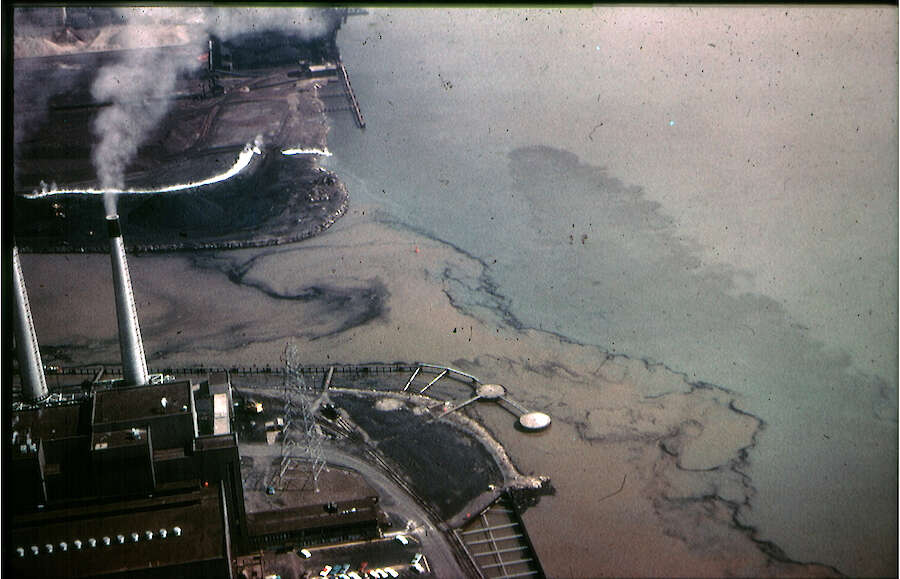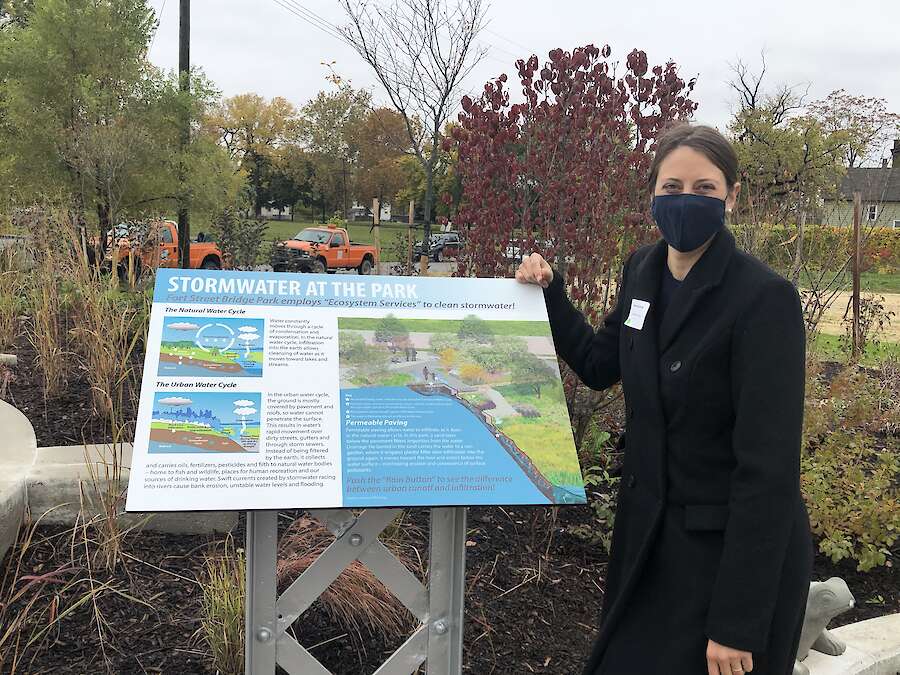Southeast Michigan's Industrial History Persists to the Present

The mouth of the Rouge River, in 1965, depositing sediments and other pollutants into the Detroit River. Photo courtesy of the Friends of the Rouge.
Michigan has been synonymous with American industry since at least 1900. Once a center for timber and mining, Michigan became home to many industries, including copper, iron, steel, paper, oil, breakfast cereal, and, most significantly, automobile manufacturing. While industry was the heart of Michigan’s economy, its environmental and health impacts were enormous. In 1948, 11,000 ducks and geese were killed by oil discharges on the Rouge and Detroit rivers. In 1969, the floating oil and debris on the Rouge River caught on fire. Chemical and heavy metal contamination have rendered fish inedible and caused risk or harm to human health over and over again, with mercury, lead, and PFAS continuing to cause concern today. The Clinton, Rouge, and Detroit Rivers all remain active Great Lakes Areas of Concern, as established by the Great Lakes Water Quality Agreement in 1987. Environmental activism led to decreases in pollution and industrial regulations, but more work remains to be done to clean up contamination from the past and keep Southeast Michigan a beautiful and safe place to live.
Urbanization is Causing Increased Flooding During Storms

Sprawling suburbs throughout southeast Michigan increase runoff. Photo by Ken Lund.
Flooding is one of the most devastating natural disasters many communities face in Southeast Michigan. Replacing forests and wetlands with hard surfaces, channelizing and burying streams, and building developments in floodplains has made floods more common and more dangerous. Worryingly, the number of floods is increasing in recent years and flooding may only get worse as climate change brings more rain and more frequent, heavy storms to the Midwest.
The impact of flooding is felt across social, economic, and environmental indicators. The high cost of floods drags down the economy by damaging properties and destroying crops. In the highly developed Rouge and Detroit rivers, floods overwhelm aging wastewater infrastructure and release diluted raw sewage into waterways. This in turn can impact human health, water, recreation, and environment scores by increasing harmful bacteria in local waters. Solving flooding issues will be essential to the long-term vitality of Southeast Michigan. The promotion of wetland restoration and green infrastructure development will improve flood resilience in the region. Local watershed organizations restore ecosystems across their watersheds, install and maintain large- and small-scale green infrastructure solutions like rain gardens, and promote sustainable development to local businesses and homeowners. Continued efforts at the household, municipal, and county levels will ensure that future floods are less likely to be destructive to communities.
Nutrients are Degrading Water Quality
 Human development and intensive agriculture can negatively impact water quality. Roofs and roads deflect rain water rather than absorbing it, so chemicals and debris are can be washed into rivers and streams. Pesticides and fertilizers used on agricultural fields or private lawns also end up in waterways. Fertilizers contain nitrogen and phosphorus to help plants grow; in rivers and lakes, these nutrients can cause algal growth. This can lead to low dissolved oxygen as the algae decomposes. Algal blooms can lead to biodiversity loss and be a nuisance to people. Particularly alarming are the Harmful Algal Blooms (HABs) that can form in the summer. These blooms are harmful because of the chemicals produced by the algae, which impact the safety of drinking water for millions of people. Watershed organizations in Southeast Michigan work to prevent nutrient loading and HABs in many ways. Healthy and intact riverfront habitat absorbs runoff from developed areas. Tree or wetland buffers around agricultural fields can reduce fertilizer runoff. These measures help protect river ecosystems and keep the water drinkable and usable for the people of Southeast Michigan.
Human development and intensive agriculture can negatively impact water quality. Roofs and roads deflect rain water rather than absorbing it, so chemicals and debris are can be washed into rivers and streams. Pesticides and fertilizers used on agricultural fields or private lawns also end up in waterways. Fertilizers contain nitrogen and phosphorus to help plants grow; in rivers and lakes, these nutrients can cause algal growth. This can lead to low dissolved oxygen as the algae decomposes. Algal blooms can lead to biodiversity loss and be a nuisance to people. Particularly alarming are the Harmful Algal Blooms (HABs) that can form in the summer. These blooms are harmful because of the chemicals produced by the algae, which impact the safety of drinking water for millions of people. Watershed organizations in Southeast Michigan work to prevent nutrient loading and HABs in many ways. Healthy and intact riverfront habitat absorbs runoff from developed areas. Tree or wetland buffers around agricultural fields can reduce fertilizer runoff. These measures help protect river ecosystems and keep the water drinkable and usable for the people of Southeast Michigan.
How You Can Help

Rain garden installations and public education can improve the management of stormwater and runoff. Photo courtesy of the Friends of the Rouge.
Improving the watersheds of Southeast Michigan is a collaborative effort between scientists, government officials, and residents. There are a variety of actions that you can take to help protect your river and watershed. At home, you can plant rain gardens, reduce use of fertilizers and pesticides, and make use of local parks and recreation areas. In your community, you can volunteer with watershed organizations, participate in river cleanups, tell your leaders to protect land and rivers, and support local small businesses.
